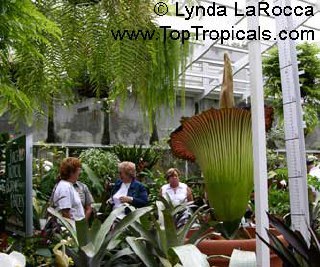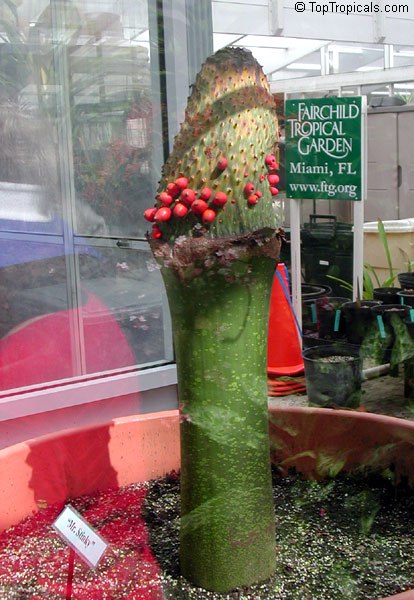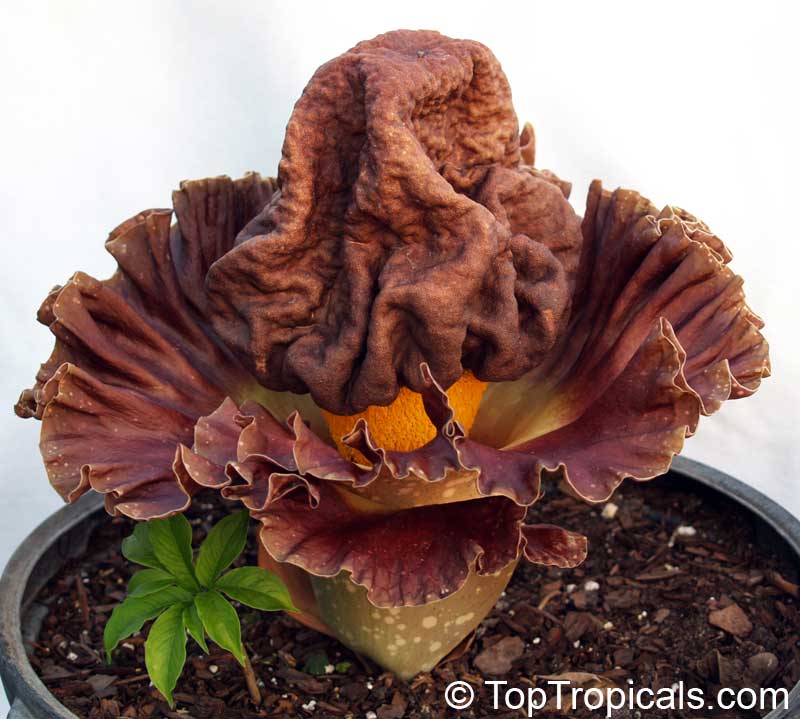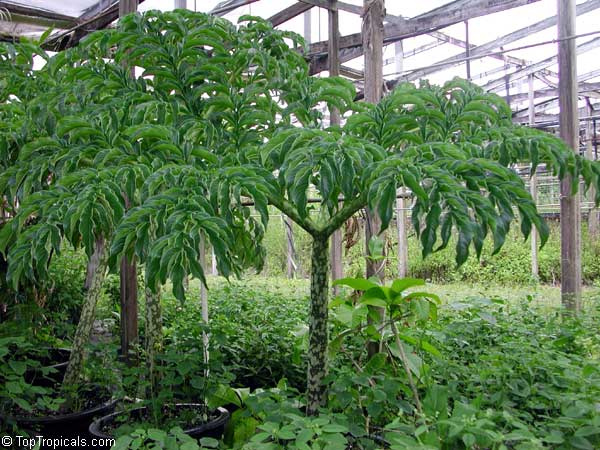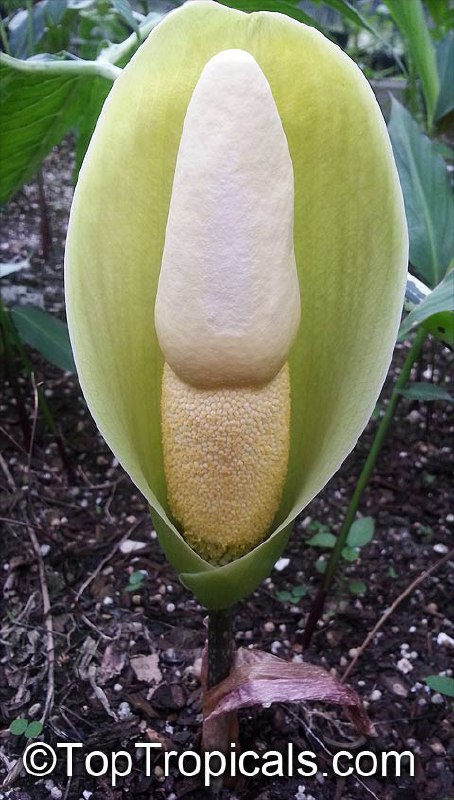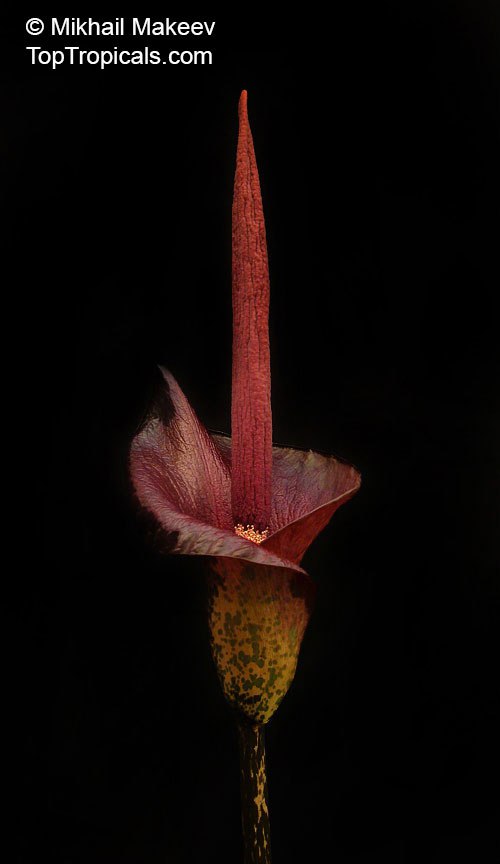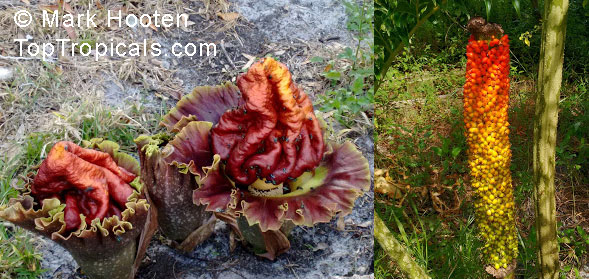Garden Blog - Top Tropicals
Whats inside the Devils Tongue that smells like trouble?
Amorphophallus paeoniifolius (campanulatus) - Voodoo lily
- 👹 Amorphophallus plants - the Voodoo Lilies - are also known as Devil's tongue, Snake Palm, or Elephant Foot Yam, Corpse flower. This plant has a reputation as wicked as its name!
- 👹 Amorphophallus is the largest flower in the world and one of the most exotic bizarre flowers. Amorphophallus titanum is known for its massive size, its flower can reach heights of over 10 feet and blooms only once every few years.
- 👹 Why Corpse flower? Because of the smell that the flower omits, but for only a few hours - just long enough to summon its pollinators, the flies 🐱
- 👹 The titan of the group, Amorphophallus titanum, can soar over 10 feet tall. But its cousin in this video, Amorphophallus paeoniifolius, is just as fascinating. It rises from a giant underground corm (which is actually edible in Asia), then sends up either one surreal flower or one umbrella-like leaf as big as a small tree.
- 👹 Season after season, it alternates between leaf and bloom, keeping its mysterious cycle alive. Hardy enough to rest through winter dormancy, it can even be grown in a pot at home.
After that, the air clears, leaving only the memory of the spectacle.
🎥 Amorphophallus paeoniifolius (campanulatus) - Voodoo lily
🛒 Discover more of Amorphophallus - rare and enigmatic plants
📚 Learn more:
#Nature_Wonders #Shade_Garden #Container_Garden
🟢 Join 👉 TopTropicals
The biggest flower in the world - Amorphophallus
Amorphophallus bulbifer
After meeting Sausage Tree and Clitoria, are you ready for the Amorphophallus? Now you have seen everything!
- 💀 Common names of this exceptional plant: Voodoo lily, Devils tongue, Snake Palm, Elephant Foot Yam, Corpse flower.
- 💀 Why Corpse flower? Because of the smell that the flower omits, which is only present for a few hours after the flower opens - to attract pollinator flies!
- 💀 Amorphophallus is the largest flower in the world and one of the most exotic bizarre flowers. Amorphophallus titanum is known for its massive size, its flower can reach heights of over 10 feet and blooms only once every few years.
- 💀 This perennial exotic Asian plant grows a single, elongated center called a corm (that is actually edible) and a single large leaf that wraps around it.
- 💀 The seed stalk is very pretty with the seeds changing colors from green to red. During this time the tuber will not produce a leaf. After the flower and seed stalk dies away, a giant single leaf grows from the tuber.
- 💀 The single leaf dormant in winter, then in spring the plant shoots out this fantastic flower again.
- 💀 It is relatively cold hardy tropical and can survive cooler winters during dormancy.
- 💀 Can be easily grown in a pot as a houseplant.
🎥 Amorphophallus bulbifer and other specials in next post.
🛒 Shop Amorphophallus
#Nature_Wonders #Shade_Garden #Container_Garden
🏵 TopTropicals
Fun Fact: Voodoo Lily

Amorphophallus konjak - Voodoo Lily plant

Amorphophallus konjak - Voodoo Lily, flower
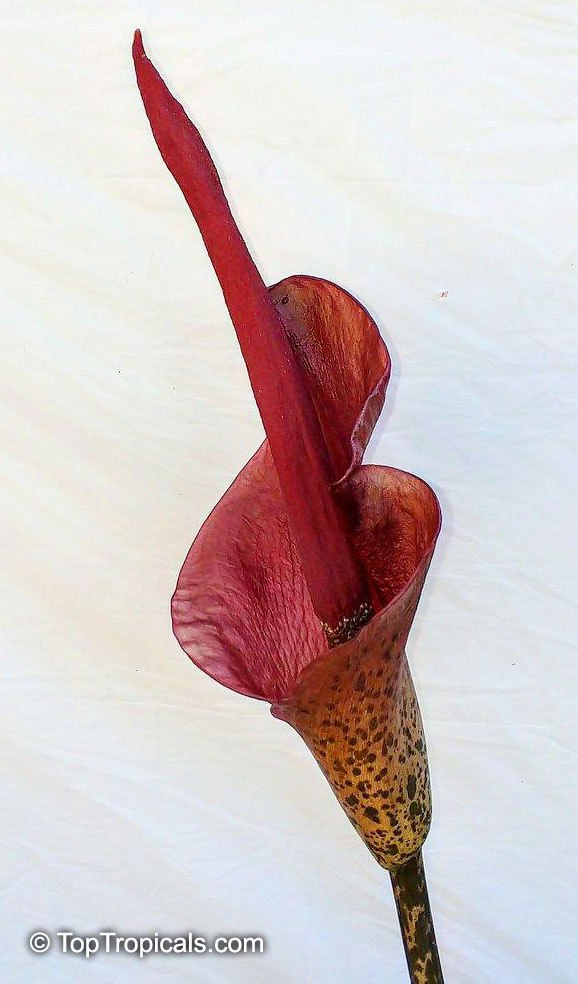
Amorphophallus konjak - Voodoo Lily, flower
👹 Amorphophallus konjak - Voodoo Lily, blooms from a single corm and releases an unforgettable scent, often compared to rotting meat. Despite its bizarre appearance and smell (that only lasts one day!), it's a showstopper that can easily be grown as a houseplant.
#Fun_Facts #Nature_Wonders #Container_Garden #Shade_Garden
🛒 Shop Amorphophallus
🔴 Join 👉 TopTropicals
Date:
Elephant Foot Yam seed production
Q: Very interesting information about Amorphophallus in your recent newsletter! (which I always enjoy BTW). I would like to purchase those fresh seeds, and I have a couple of questions. Did you have to hand pollinate that flower? I've heard it is not easy to set a fruit. Also, is this an edible variety?
A: From
Mark Hooten, the Garden Whiz. These Elephant Yam seeds were produced as
a result of hand pollination between two different Amorphophallus
paeoniifolius plants grown from entirely different sources. Both plants over ten years
old. One corm originated from a traditional Chinese market here in Ft. Myers,
while the other came from a Hindu market in Naples. As both were being sold
for eating (the prepared corms of the sweet types are a popular Asian
vegetable), we know they are of the "sweet" type, not the acrid type which is the
commonest in cultivation. The flowering occurred this last April, with the fruit
spike maturing in October which is very fast considering it may take up to a
year to mature this fruit!
The flowering image shows three different flowers all emerging from a
single clump of the Chinese plant which has developed over the years, each
flower being a couple of days apart. This is the plant which made the
fruit-spike, one of its flowers having been hand pollinated by the Hindu store plant on
the other side of the property. Notice all of the large blue flies swarming
the fully mature and very stinky flower!
Check out Fresh seeds of Amorphophallus paeoniifolius. Only a few packs left!
The bizarre bloom you cant stop staring at
Stapelia gigantea - Zulu Giant, Carrion Plant
- ⭐️If there were an award for the strangest flower, the Starfish Flower - Stapelia gigantea - would be a top contender. Also known as the Zulu Giant or Carrion Plant, it produces massive blooms, sometimes 12 inches across, that look exactly like starfish. The pale ochre-yellow petals are lined with fine maroon stripes, giving the flowers a texture and color you can't ignore.
- ⭐️ And then there's the smell!🐱
- ⭐️The plant itself is a stunner even without flowers, with chunky, 4-angled succulent stems that sprawl sideways. In the ground, it can spread up to 24 inches wide, and in a pot, it makes a fantastic conversation piece. Despite its cactus-like appearance, it's actually a member of the Milkweed family. When it sets seed, each pod bursts to release silky parachutes that float away just like milkweed.
- ⭐️It's bizarre, beautiful, and guaranteed to get people talking!
Its nickname Carrion Plant comes from its uncanny scent of rotting meat. While that might not sound appealing, it's a brilliant strategy for attracting its pollinators - flies - who can't resist investigating! Just like Amorphophallus - Corpse flower! 🐱
🛒 Add the Zulu giant to your garden
📚 Learn more:
The most bizarre flower
🎥 More video:
- 📱 on YouTube
- 📱 on TikTok
#Nature_Wonders #Container_Garden
🟢 Join 👉 TopTropicals
What flowers do NOT attract bees?
Butterfly on a flower that doesn't attract bees
Most tropical flowers bring in pollinators, and bees are usually first in line. But what if you’d rather avoid them? Maybe you’re allergic, or just don’t want bees buzzing around. Good news: some flowers attract butterflies, hummingbirds, moths, or even flies - but not bees.
- 👉 Quick rules:
- ✔️ Night-blooming + strong fragrance = moths or bats, not bees.
- ✔️ Red tubular flowers with little scent = hummingbirds or butterflies, not bees.
- ✔️ Rotten or fermented smell = flies, not bees.
- ✔️ Carnivorous plants = trap insects, no bee nectar.
1. Night-blooming, fragrant - moth and bat flowers
Bees forage by day, so many night-fragrant flowers skip them.
- ▫️Brugmansia - Angel’s Trumpet - big, hanging blooms, moth and bat pollinated.
- ▫️Cestrum nocturnum - Night-blooming Jasmine - powerful night scent, moths only.
- ▫️Hylocereus Dragon Fruit - huge cactus flowers, bats and moths.
- ▫️Brunfelsia - Lady of the Night - sweet fragrance at dusk, no bee interest.
- ▫️Hibiscus - hummingbirds and butterflies visit, bees less so.
- ▫️Heliconis and Gingers - designed for hummingbird beaks, bold tubes are for birds, not bees.
- ▫️More good picks: Ruellia, Sanchezia, Aeschynanthus, Aphelandra, Anisacanthus, Cuphea, Fuchsia, Iochroma, Justicia, Lonicera, Hamelia, Russelia, Odontonema, Tecomaria, Bougainvillea.
- ▫️Amorphophallus (Voodoo Lily) - rotting meat scent.
- ▫️Tacca (Bat Head Lily) - spooky black flowers, fly-pollinated.
- ▫️Stapelia (Carrion Flower) - also fly-pollinated.
- ▫️Aristolochia (Pelican Flower) - giant, bizarre fly-traps.
- ▫️Vanilla orchid - its natural bee pollinator is absent in most regions, so no bee appeal elsewhere.
- ▫️Brassavola nodosa and others - open at night for moths, not bees.
- ▫️Nepenthes (Pitcher Plant) - uses pitchers of liquid to lure and digest insects.
2. Hummingbird and butterfly flowers
Bees don’t see red well. Tubular reds, oranges, and yellows usually go to birds and butterflies.
3. 🐱 Fly-pollinated oddballs
Some flowers smell bad to us but irresistible to flies.
4. 🌸 Specialized orchids
Not all orchids rely on bees. Many use moths, butterflies, or beetles instead.
5. 🕷 Bonus: carnivorous curiosities
Carnivorous plants don’t offer nectar. They trap insects instead, so bees stay away.
These flowers keep the beauty, fragrance, and wildlife appeal - but without making your garden a bee hotspot.
🛒 Explore butterfly attractors
#Butterfly_Plants #How_to #Discover
🟢 Join 👉 TopTropicals
Date:
Capricorn - 12/22 - 1/19.
An EARTH sign ruled by the planet Saturn. Capricorn's plants usually have few flowers, or small flowers, are knobby or woody, and may have an unpleasant smell or taste. Saturn rules plants with long lives and slow growth, so plants with annual rings are also associated with the Goat.
Physiologically, Saturn rules the systems that give the body its structure and form: the skeletal system, and the skin, teeth, joints, and knees, so plants that are high in calcium can be very beneficial. Those can be woody plants and shrubs that show annual rings, as well as some poisonous or narcotic plants. Saturn plants are useful in treating arthritis and rheumatism. Traditional Capricorn appreciates a spice that is powerful but familiar. Black pepper adds flavor and a bit of heat to both food and life, creating movement without too much change.
Capricorn Zodiac lucky plants:
Baobab, Peach Palm, Patchouli, Bamboo, Cordyline, Spider Lily, Serissa, Desert Rose, Croton, Aloe, Palms, Giraffe knee plant - Gonatopus boivinii, Adenanthera, Black Pepper, Solanums, Loquat, Aglaonema, Jacaranda, Rosemary, Shisham - Dalbergia sissoo, Neem Tree, Calendula, Brugmansia, Cannabis, Coca, Kava-Kava, Root Beer plant, Kratom, Banesteriopsis, Psychotria, Quince, Almonds, Ginkgo, Olive, Strophanthus, Bread Flower, Amorphophallus, Areca Palm, Anadenanthera, all Pipers, Brunfelsia, Chaya, Persimmons, Surinam Cherry, Bel Fruit, Ashoka Tree, Calla Lily.
For other signs information, see full Plant Horoscope.
Date:
Virgo - 8/23-9/22. Virgo is an EARTH sign ruled by the planet Mercury, which also rules Gemini.
Virgo is traditionally the Goddess of the Grain, and is associated with autumn. Her plants often have finely divided leaves or stems, subtle odors, or small, brightly-colored flowers. The most beneficial plants for Virgo are high in potassium and help to calm the nerves.
In its rulership of Virgo, Mercury governs the abdomen and the lower intestinal tract and the entire digestive process. Herbs associated with Virgo assist in digestion (as do Cancer herbs) and help to reduce flatulence. The relaxing, calming scents help Virgo release stress and worries.
Virgo Zodiac lucky plants: Amorphophallus, Anethum graveolens (Dill), Barringtonia, Bolusanthus, Dioscorea, Grewia asiatica (Falsa), Hibiscus sabdariffa (Karkade), Iboza riparia, Lagerstroemia speciosa (Queens Crape Myrtle), Laurus nobilis (Bay Leaf), Lippia, Melissa, Catnip, Mint, Arugula, Piper betle, Piper sarmentosum, Psychotria, Syzygium aromaticum (Clove), Banisteriopsis, Papaya, Mesua ferrea (Ironwood), Momordica, Euterpe oleracea (Assai Palm), Jacaranda, Magnolia officinalis, Pimenta dioica (Allspice), Osteospermum, Petrea, Plumbago, Clitoria, Eranthemum, Litchi, Cashew, Pecan, Nut trees, Cherries, Lavender, Myrtles, Sansiveria, Aloe vera, Blackberry, Honey suckle, Satureja, Vitex, Mulberry, Elaeocarpus, Clausena lansium (Wampi), Feronia elephantum (Bel Fruit).
For other signs information, see full Plant Horoscope.
Date:


Capricorn - 12/22
- 1/19.
An EARTH sign ruled by the planet Saturn. Capricorn's plants usually have
few flowers, or small flowers, are knobby or woody, and may have an unpleasant
smell or taste. Saturn rules plants with long lives and slow growth, so
plants with annual rings are also associated with the Goat.
Physiologically, Saturn rules the systems that give the body its
structure and form: the skeletal system, and the skin, teeth, joints, and knees, so
plants that are high in calcium can be very beneficial. Those can be woody
plants and shrubs that show annual rings, as well as some poisonous or
narcotic plants. Saturn plants are useful in treating arthritis and rheumatism.
Traditional Capricorn appreciates a spice that is powerful but familiar. Black pepper adds flavor and a bit of heat to both food and life,
creating movement without too much change.
Capricorn Zodiac
lucky plants:
Baobab, Peach Palm, Patchouli, Bamboo, Cordyline, Spider Lily, Serissa, Desert Rose, Croton, Aloe, Palms, Giraffe knee plant - Gonatopus boivinii, Adenanthera, Black Pepper, Solanums, Loquat, Aglaonema, Jacaranda, Rosemary, Shisham - Dalbergia sissoo, Neem Tree, Nutmeg, Calendula, Brugmansia, Cannabis, Coca, Kava-Kava, Root Beer plant, Kratom, Banesteriopsis, Psychotria, Quince, Almonds, Ginkgo, Olive, Strophanthus, Bread Flower, Amorphophallus, Areca Palm, Anadenanthera, all Pipers, Brunfelsia, Chaya, Persimmons, Surinam Cherry, Bel Fruit, Ashoka Tree, Calla Lily.
For other signs information, see full Plant Horoscope.
